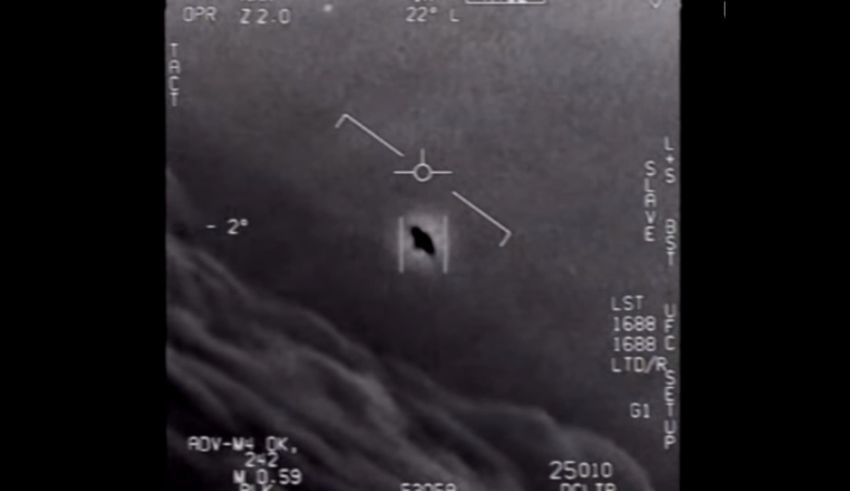
Regarding the controversial 2015 UFO incident, a Pentagon official disclosed in a major development that it has cracked the riddle behind the unidentified object sighted over the Atlantic Ocean by a Navy fighter jet. Captured in grainy, black-and- white infrared video recorded from the head-up display of a fighter pilot’s helmet, the object became known as the “Go Fast” UFO. As the unidentified item swiftly crosses the screen in the footage, the pilot yells, “Ohhh, go it!”
One of several UFO sightings involving Navy personnel later made public, this one piqued great interest and conjecture. Consequently, the “Go Fast” UFO soon attracted close examination and military professionals as well as the public tried to interpret what was truly observed that day. The Pentagon is now providing an official justification for the UFO sighting in a recent statement to Congress, but this new story has simply helped to generate further questions among professionals and witnesses.
Pentagon’s fresh justification: a trick of the eye?
Under oath Tuesday, newly appointed Director of the Department of Defense’s All-Domain Anomaly Resolution Office (AARO), Dr. Jon Kosloski, testified before the Armed Services Committee. Declaring that the “Go Fast” object’s high-speed look was only the consequence of an optical illusion known as “parallax,” he offered the official Pentagon explanation. Kosloski clarified that although the object looked to be flying near the sea at a very fast speed, in fact it was significantly further away and at a far higher elevation. The AARO’s study indicates that the item was probably traveling at roughly 13,000 feet, not near the water as it looked on film.
Kosloski’s theory makes use of a well-known optical phenomena known as “parallax,” whereby the position of an object seems to change depending on the viewpoint from which it is seen. He contended that the relative motion of the Navy fighter jet produced an illusion whereby the object seemed to be traveling quickly. The fighter jet’s speed as well as the distance separating the object from the jet gave the impression of quick mobility. According to Kosloski’s account, the object was somewhat higher in the sky rather than as near to the sea as first appeared.
Many analysts and military witnesses have voiced reservations about this idea notwithstanding the Pentagon’s justification. Those who were there during the encounter as well as independent investigators and experts have questioned the government’s assertion that the UFO is just a trick of the eye.
A Growing Chorus of Questions: Professionals Challenge the Pentagon’s Response
Former military officials, climate scientists, and critics have responded angrily to the Pentagon’s justification, contending that the “parallax” theory falls short in properly explaining the intricate specifics around the sighting. Ryan Graves, a former U.S. Navy lieutenant and F/A-18F fighter pilot who has been public about his worries about the government’s handling of UFO encounters, is among the most vociferous critics of their stance. Graves, who also participated in the same time of UFO contacts, claimed that the Pentagon’s justification ignores the whole extent of the experience.
Graves noted that the object seen in the “Go Fast” video was not a single UFO but rather a component of a greater formation of objects seen by several airmen. Graves claims that the sight is particularly confusing as these UFOs are so far off the coast—300 miles from land and inside 50 miles of a U.S. aircraft carrier. Given their observation over limited territory, he also remarked that the objects were clearly a flight safety hazard.
Graves further underlined that the pilots engaged in the incident had never called the object the “Go Fast” UFO. This designation, he claimed, was imposed by the Pentagon long after the incident, therefore distorting the lines of the official inquiry. Graves maintains that the fundamental worry was not that the object was only “moving fast,” but rather that it belonged to a more general, more aberrant category of UFOs.
Public Interest in UFOs Rekindles Following leaked videos
Three Navy pilot infrared recordings, documenting what the Pentagon has formally termed “unidentified anomalous phenomenon,” (UAP), published in 2017 sparked public interest in UFOs. Including the “Go Fast” clip, these movies revived long-standing conjecture on the nature of UFOs and the likelihood of extraterrestrial life. The Pentagon was under increasing pressure to provide a clear justification of what Navy pilots had seen while the public kept closely examining these reports.
Particularly the “Go Fast” film, which portrayed an object soaring over the water at an unknown speed, became one of the most often spoken about UFO encounters. Although the Pentagon’s most current justification—based on the “parallax” effect—claims that the object was not moving at the speeds first proposed—this idea has been greeted with conflicting opinions from both professionals and the public.
The speed of the object is among the main sources of conflict. The item in the video seemed to be traveling at an amazing speed, which led many to believe it could be an advanced piece of technology, maybe alien in source. Still, Kosloski’s theory—that the fighter jet’s velocity created an illusion of the object’s speed—has not silenced these conjectures. Many feel that the government’s attempt to minimize the conduct of the object falls short as a suitable justification.
Growing skepticism: the function of independent simulations and climate scientists
Independent study by climate experts and computer simulations has added to the doubts about the Pentagon’s justification. The wind speed data is one main source of conflict since it runs counter to Pentagon estimates. Researchers have gotten wind speed data from the time and location of the sighting using the ERA5 dataset of the European Centre for Medium-Range Weather Forecasts. This information casts doubt on the alleged speed of the UFO since it shows that wind speeds at the time of the encounter were far stronger than what Pentagon investigation indicated.
Particularly, the wind speeds at 25,000 feet, where other UFOs were observed in the same hour, were noted at 120 knots, far higher than the 60 knots mentioned by the Pentagon. Some calculations carried out by prominent UFO critics, such as Mick West, have indicated that the object in the “Go Fast” film most certainly was moving at a speed far higher than the 40 mph the Pentagon first suggested. Far beyond the official government explanation, these calculations place the object’s speed more near to 100 knots or 115 mph.
New Analysis by the Pentagon: Examining the “Parallax” Effect More Closely
Recent evidence from Kosloski has drawn more attention to the “parallax” phenomenon he claims produced the apparent speed of the object. Kosloski claims that the object seemed to be skimming the ocean as its actual height was roughly 13,000 feet, significantly higher than the surface of the water. He says the relative motion of the fighter jet and the item causes the phenomena.
Kosloski contends that the variations in altitude and the angle from which the object was seen caused the Navy fighter jet to perceive it as moving quickly while it recorded the target. Trigonometry and meticulous video analysis have helped Pentagon investigators determine that the item was not moving quickly near the sea. Rather, they claim that the way it was shot caused the object to seem faster and to be higher in the heavens.
Still, the debate on the “Go Fast” UFO is unsolved even with this justification. Critics contend that given the greater formation of UFOs seen by air personnel, the government’s reliance on the “parallax” effect does not adequately explain the larger background of the encounter.
Although the Pentagon’s official justification for the 2015 “Go Fast” UFO sighting presents a fresh viewpoint on the incident, it has done little to allay the mounting mistrust and continuous discussion. The real nature of the UFO sighting stays elusive as military troops, independent investigators, and climate experts challenge the government’s story. One thing is certain: the public is still enthralled with the mystery of the UFOs caught by the Navy, whether the “Go Fast” object is a product of modern technology, an optical illusion, or something else entirely. With no clear answer in sight. The hunt for solutions to this confusing phenomena is far from finished as professionals and citizens both keep examining the video and the events surrounding it.























